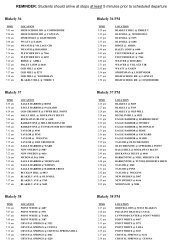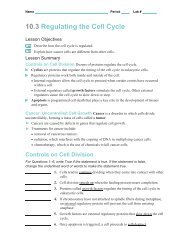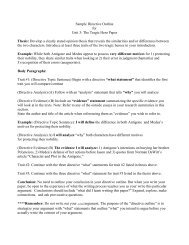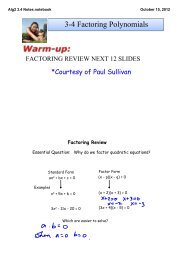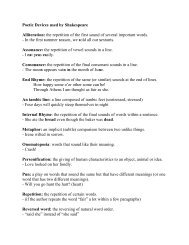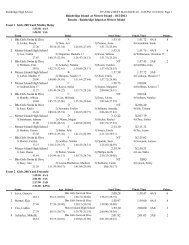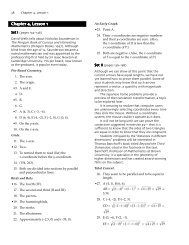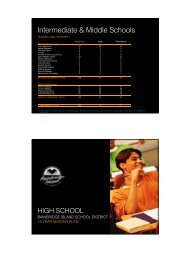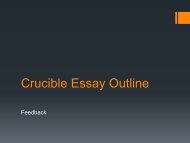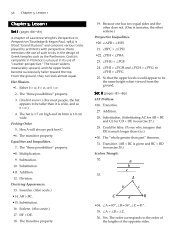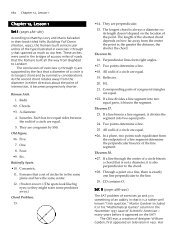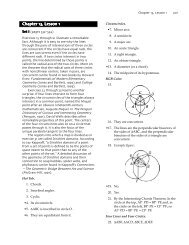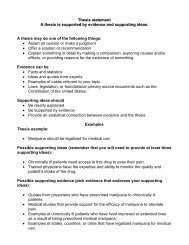Chapter 14 Answers - BISD Moodle
Chapter 14 Answers - BISD Moodle
Chapter 14 Answers - BISD Moodle
Create successful ePaper yourself
Turn your PDF publications into a flip-book with our unique Google optimized e-Paper software.
<strong>Chapter</strong> , Lesson Set II (pages –)József Kürschák, the man associated with thegeometric proof that the area of a regulardodecagon having radius r is r , was a professorof mathematics at the Polytechnic University inBudapest for many years. He is also rememberedas the author of the Hungarian Problem Books Iand II, still available in the New MathematicsLibrary of the Mathematical Association ofAmerica.Honeycomb Geometry.44. That they are 150°. [180° – 2(15°).]45. ∠AHI = ∠HIC = 150°. [2(60°) + 2(15°).]46. r. (DH = DI = AB = BC = CD = DA = r.)•47. AH = HI = IC = (2 sin 15°)r ≈ 0.518r. [AH,HI, and IC are sides of a regular dodecagonwith radius r. Its perimeter is 2(12 sin 15°)r;so the length of each side is (2 sin 15°)r.]48. DE = DF = DG = (2 sin 15°)r ≈ 0.518r. (Theyellow triangles are isosceles.)29. Equilateral.30. An apothem.•31. 30°-60° right triangles.•49.r 2 . (BAHIC contains one-fourth of theexamples of each type of triangle that makeup the square.)•32. .50. r 2 . (r 2 – r 2 .)33. .•34. .35. .[αABCDEF = 6α∆AOB = 6( r 2 ) = r 2 .]36. (6 sin 30° cos 30°)r 2 .37. In ∆BOP, sin ∠BOP = = = .38. In ∆BOP, cos ∠BOP = = = .39. (6 sin 30° cos 30°)r 2 = (6( )( ))r 2 = .40. Yes. It agrees with the answer to exercise 35.Kürschák Triangles.41. ∆FHI and ∆BHI. Because they are equilateraland share a side, they are congruent by SSS.(Or, because they share a side and have 60°angles, they are congruent by ASA or SAS.)•42. They are isosceles.51. r 2 . (α∆DAH = αDAHIC.)Rats!52. (Student answer.) (The square has the largerradius.)53. (Student answer.) (The square has the largerperimeter.)•54. 7.1 cm. [100 = 4(sin 45° cos 45°)r 2 , 100 = 2r 2 ,r 2 = 50, r = ≈ 7.1.]55. 6.5 cm. [100 = 5(sin 36° cos 36°)r 2 ,100 ≈ 2.38r 2 , r 2 ≈ 42.0, r ≈ 6.5.]56. 40 cm. (Because s 2 = 100, s = 10, andp = 4s = 40.)•57. 38 cm. [p ≈ 2(5 sin 36°)(6.5) ≈ 38.]58. (Student answer.) (Both the radius and theperimeter of the pentagon are smaller thanthose of the square.)Hebrew Exercise.59. The problem is to prove that the area of aregular octagon having a radius of R isR 2 .60. A = (8 sin 22.5° cos 22.5°)R 2 ≈ 2.828R 2 , andR 2 ≈ 2.828R 2 .•43. That they are 15°. ( .)



